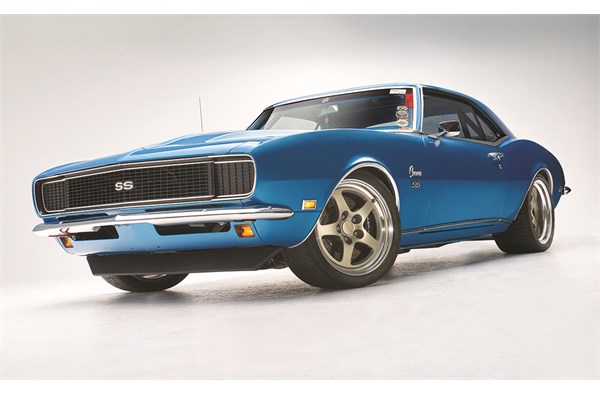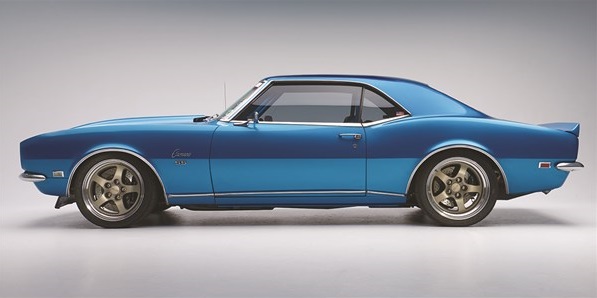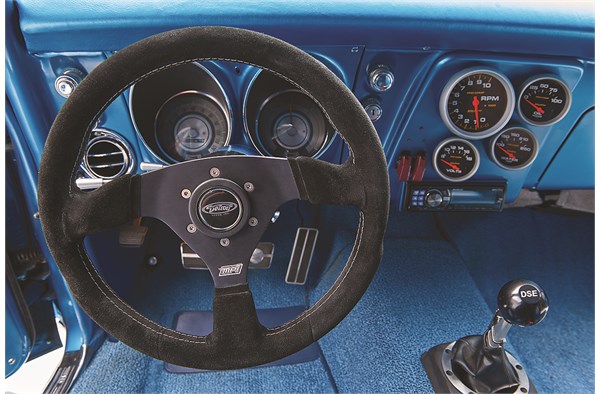Photography By: Todd Biss Productions
If you’ve spent any time in a middle school science class, you’re probably familiar with Isaac Newton and his third law of motion: For every action, there’s an equal and opposite reaction. In other words, if you push against something, it pushes right back. It’s how boats sail through the water, how planes fly through the air, and how Ray Thompson built this incredible 1968 Camaro.
Ray picked up his RS/SS back in the winter of 1979, after spotting it in the parking lot of his local shopping mall. He was just fifteen years old and eager to get behind the wheel of his first car, but even back then he knew this Camaro was in desperate need of a course correction. “It was a good 50-footer,” he recalls. “It had some rust on the floor, and according to the previous owner, the car was stolen at some point and the original driveline had been stripped out.”
True, the Camaro was merely scraping by those days with a lethargic 350 under the hood mated to an equally uninspiring 3-speed stick (rather than the original’s 396/4-speed combo), and 11 Akron winters had begun to break the sheetmetal down to its constituent parts, but none of that mattered to Ray and his freshly minted driver’s license. So in exchange for $600, he assumed ownership of the Camaro along with the dubious privilege of babying it through yet another season of Northeast Ohio snow and slush.
Like a rear-wheel-drive sports car pirouetting down an icy city street, the condition of Ray’s new-to-him Camaro had built up a certain amount of momentum which was not easily overcome. But he pushed back in a big way, cutting out and repairing the offending rust, dropping in a new 4-speed transmission and clutch, upgrading to a beefier 12-bolt rearend, and he even bolted on a few choice engine upgrades. A requisite set of Cragars got the Camaro back on the straight and narrow.
With this round of repairs and upgrades completed, the Camaro happily assumed daily driver duty for nearly a decade, until outside forces provoked a drastic and sudden change in the opposite direction. “I drove it until ’88, and then I took it apart so it’d be completely worthless,” Ray explains. “I was getting married soon, and that way I couldn’t sell it to help pay for my wedding!”
That’s right. In a heroic and heartbreaking act of musclecar preservation, Ray separated the Camaro’s body from its chassis, and—with some deft forklifting—set it high atop his office mezzanine, where it remained at rest for the next dozen years. Occasionally he’d find some time to scrape away a bit of underbody coating, replace some rotten sheetmetal, or sandblast the bits worth saving. Meanwhile, the chassis and driveline was parked in his home garage.
But in the winter of 2000 (a full 21 years after Ray originally bought the car), a sudden burst of inspiration set the Camaro project back into motion. “I was at the Detroit Autorama and I spotted this cool 1969 Camaro called ‘The Twister,’ built by a guy named Kyle Tucker,” says Ray. “The way that vehicle was set up—the way it sat—I knew that’s how I wanted my car to look.”
Ray would come to find that Kyle was heading up a small design and manufacturing outfit by the name of Tucker Hotrods (a company we’d later know as Detroit Speed), and The Twister’s aggressive road-race stance was achieved with the company’s first-ever set of tubular upper control arms, complete with adjustable-height coilovers. Remember: this was uncharted territory back at the turn of the millennium.
With all the details worked out, Ray reunited the Camaro’s body and chassis, then wheeled the whole thing up to Detroit to receive an identical set of control arms, complete with Koni coilovers. And while it was in the shop, Kyle and company beefed up the Camaro’s frame welds, added a set of mini tubs out back to accommodate some wider rolling stock, and installed a six-point roll cage for added rigidity.
Several months later, the car was back in Ohio and headed to Bob Swarm at Universal Paint in Youngstown for some bodywork and a fresh coat of that iconic LeMans Blue—the fourth shade of blue this particular F-body has worn. “The car was originally dark blue, but it had already been re-painted some lighter shade when I bought it,” Ray recalls. “Then I paid a buddy $40 to spray it Cadillac Firemist Blue after I did all the blocking and prep. It wasn’t half bad for an enamel paint job!”
Of course, Ray didn’t just sit around watching the figurative (and literal) paint dry while Bob worked his magic with a spray gun. Instead, he got to work building an engine that would take full advantage of the Camaro’s race-inspired chassis upgrades. Ray began by punching out the small block .030″, then he stuffed it with a fully balanced rotating assembly, and topped the whole thing off with a veritable buffet of aftermarket bolt-ons, including an Edelbrock Air-Gap intake, Demon 650 cfm carburetor, and an MSD ignition, then mated it all to a Tremec TKO 600.
But don’t let the build sheet fool you—this Camaro isn’t a complete track rat. “It’s not a race car—it’s a street car that likes to pretend it’s a race car,” Ray points out. And to that end, his F-body sports a custom A/C setup from Vintage Air, a modern Kenwood audio system, and leather-wrapped buckets pulled from an ’88 T-bird, all shielded from ambient heat and noise with a healthy layer of Dynamat. Of course, the Simpson 5-point harnesses, custom Auto Meter gauge setup, and suede-wrapped racing wheel ensure you don’t mistake this pro touring pony car for some run-of-the-mill Sunday cruiser.
And where does Ray take a Jekyll and Hyde Camaro such as this? Anywhere he wants! As an avid member of the Ultimate Street Car Association, he logs up to 5,000 miles per year behind the wheel, piloting his Camaro to some of America’s greatest race tracks and pushing it to the limit once he gets there. “I’ve driven this car all the way up to Road America in Wisconsin, and when I got to the track I didn’t even change the tires,” says Ray. “Just being able to get out there on the track and really unleash the car is great.”
Over the years, Ray has blasted his way around a truly impressive number of top-tier racing venues, including the Daytona International Speedway, Gingerman Raceway, and—naturally—on his home turf at Mid-Ohio, but thrashing his car up and down the Eastern seaboard eventually took its toll on the aging driveline. Luckily for Ray, an old friend had the solution. “I’d worn out the 383, and decided it needed to come out,” explains Ray. “That’s about the same time Kyle Tucker took me for a ride in his LS-powered 1970 Camaro. It had so much power and was so drama-free. I just knew I had to have it.”
 Of course, this was no simple engine swap. With the promise of modern, fuel-injected power on the horizon, Ray needed to ensure that the Camaro’s chassis was up to the task. So it was back to Detroit Speed (now located in North Carolina) for the company’s cutting-edge hydroformed subframe, and while they were in there fixing up the place, Kyle’s crew swapped the ancient rear leaf springs for a complete QUADRALink suspension setup. Finally, a factory-fresh hot-cam LS3 was nestled into position, bolted to a Legend LGT 700 five-speed transmission. To complete this latest round of upgrades, Baer brakes were added at each corner (14″ front/13″ rear), plus lightweight forged aluminum Fikse Profil 5 wheels wrapped in sticky BFGoodrich Rival tires.
Of course, this was no simple engine swap. With the promise of modern, fuel-injected power on the horizon, Ray needed to ensure that the Camaro’s chassis was up to the task. So it was back to Detroit Speed (now located in North Carolina) for the company’s cutting-edge hydroformed subframe, and while they were in there fixing up the place, Kyle’s crew swapped the ancient rear leaf springs for a complete QUADRALink suspension setup. Finally, a factory-fresh hot-cam LS3 was nestled into position, bolted to a Legend LGT 700 five-speed transmission. To complete this latest round of upgrades, Baer brakes were added at each corner (14″ front/13″ rear), plus lightweight forged aluminum Fikse Profil 5 wheels wrapped in sticky BFGoodrich Rival tires.
It doesn’t require a master’s degree in physics to predict the outcome. “The LS3 is fantastic!” says Ray. “It’s so much more user friendly than the old 383—you can just be going along, then put your foot to the floor and take off. Plus it gets better fuel mileage, and it sounds better, too. It even has a warranty!”
Ray spent nearly four decades transforming his first car into the only one he’d ever need, constantly pushing to find the perfect balance of horsepower, handling, modern upgrades, and classic design. And there’s no arguing with the results—this all-in-one Camaro straddles the divide between track weapon and highway cruiser so impossibly well that even our old friend Sir Isaac Newton would be left scratching his head
FAST SPECS
Chassis
Suspension: Detroit Speed Hydroformed front subframe with tubular control arms, Detroit Speed QUADRAlink rear suspension kit, JRi coilovers
Wheels and Tires: Fikse Profil 5 wheels (18” x 10″ front, 18″ x 12″ rear), BFGoodrich Rival tires(255/40R18 front, 315/35R18 rear)
Brakes: Baer Track disc brake system (six-piston front/four-piston rear calipers, 14″ front/13″ rear rotors)
Other Modifications: Detroit Speed mini tubs and 6-point roll cage, Detroit Speed rack-and-pinion steering
Engine & Transmission
Engine: GM 376/480 LS3
Exhaust: Detroit Speed stainless steel headers, custom-bent 3″ stainless steel tubing, Borla ProXS mufflers
Transmission: Legend LGT 700 five-speed transmission, Centerforce twin-disc clutch, Hurst Competition Plus shifter with line lock
Rear End: Ford 9″ Trac-Lok differential
Other Modifications: Aeromotive A1000 fuel pump
Body & Interior
Paint Color: GM LeMans Blue
Paint By: Bob Swarm, Universal Paint (Youngstown, OH)
Seating: 1988 Ford Thunderbird seats (re-covered), Simpson 5-point racing harnesses
Steering: MPI steering wheel, Ididit Retrofit steering column
Gauges: Autometer Pro-Comp gauges in custom dash insert
Interior By: Curly Brannon (Tallmadge, OH)
Other Modifications: Auto Custom Carpet Custom-Fit carpet, Vintage Air Builder Series air conditioning system, Kenwood CD head unit with Alpine speakers, ZL2 hood with Ring Brothers hinges
Special Thanks
Thanks to my wife, Lori Thompson; my brother, Joe Thompson; Bob Swarm; Kyle Tucker, Earl Bronson; and Lil’ John




These engine swaps with these washer machine motors that belong in a motel Landry room is a discrace to muscle cars takes away the true ❤️ and soul of any muscle car the plastic eight coil set up is the copy of a laundry mat side load machine I know worked on many what ever power hum bug sell it don’t destroy it sell it to a muscle car lover
Hi my dream car is the1968 camaro ssi would love to have one some day before i leave this world
It’s his car to do as he pleases but I pass on anything not original from factory.